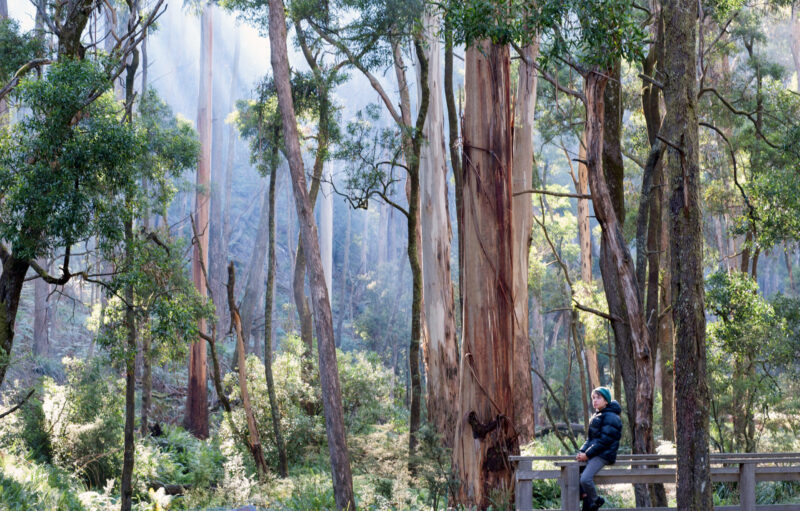PARK WATCH Article June 2025 |
Katherine Best is researching habitat augmentation strategies to maintain Greater Glider populations where natural hollows are unavailable
What’s the elevator pitch for your PhD?
The cessation of native forest logging in Victoria’s Central Highlands marked a pivotal shift in forest management. Logging significantly reduced the number of old-growth trees, and thus also hollows. Hollows can take over 120 years to form, leaving a multi-decade gap where few suitable ones are available to cavity-dependent animals like Greater Gliders (Petauroides volans), threatening their populations.
While restoration activities such as tree planting and re-seeding are planned, these strategies fail to address the immediate lack of hollows. Greater Gliders are currently facing a ‘bed and breakfast’ bottleneck: while there is still plentiful high-quality browse (‘breakfast’), suitable shelter sites (‘beds’) are scarce.
By focusing on hollow augmentation strategies (i.e. insulated nest boxes and artificially carved hollows), this research offers a potential stopgap solution to maintain glider populations during the critical period when natural hollows are unavailable.
The rapid acceptance of specially-designed, thermally-suitable nest boxes by some Greater Gliders following the 2019-2020 bushfires indicates that habitat augmentation at a landscape scale could significantly aid in population recovery. Building on that research, I will investigate whether the addition of nest boxes can help Greater Gliders recolonise previously logged forests, which may have abundant browse trees but lack natural hollows.
Since nest boxes have a limited lifespan, I will also explore whether Greater Gliders will use artificially carved hollows, which could provide a longer-term, more cost-effective solution to the lack of hollow-bearing trees in young forests.
Additionally, I am conducting a small-scale radio-tracking study to better understand Greater Glider movement patterns, shelter selection, and habitat use in relation to these artificial hollows.
Ultimately, my research aims to determine whether we can successfully put the ‘bed’ back into ‘bed and breakfast.’ The findings will help inform and improve future decision-making, leading to better forest restoration outcomes for Greater Gliders.
By filling critical knowledge gaps about artificial hollow use and their efficacy, my work will hopefully build the scientific foundation needed to support more effective, evidence-based restoration strategies for hollow-dependent species in degraded forests.
What led you to do this PhD?
I was about 20 when I became aware of native forest logging in Victoria. I remember being unable to comprehend it. How could anyone look at these magnificent trees and see only profit? Around that time, I came across the Great Forest National Park campaign, and Sarah Rees connected me with the Wildlife of the Central Highlands (WOTCH) team. That conversation, more than eight years ago, marked the beginning of my deeper involvement in forest conservation.
Somewhere along that journey, I fell completely in love with these forests and their inhabitants. There’s something about being in those landscapes that feels like home, and when I’m away, I long to return. Maybe, in some prior life, I was a forest creature… who knows!? What I did know is that if I were ever to undertake a PhD, it had to be on the forests of the Central Highlands.
After years of emotionally intense involvement in the so-called ‘Forest Wars’ – campaigning, surveying and documenting destruction – the chance to focus on restoration feels deeply meaningful. That work often felt reactive, urgent and emotionally exhausting. In contrast, this PhD offers a different kind of contribution; it allows me to shift from resistance to restoration, and to engage in work that builds toward long-term solutions for the recovery of Greater Gliders and the ecosystems they depend on.
What’s the most interesting thing you’ve learnt so far?
I’m still in the early stages of my PhD, but one of the most eye-opening lessons has been the complexity of implementing habitat restoration in the Central Highlands in a way that is both scientifically rigorous and logistically feasible. It is a mammoth undertaking!
What challenges have you had to overcome?
One of the biggest challenges has been identifying suitable trees for artificial hollows; trees that are close enough to existing glider populations to be useful, but that are also structurally sound, free of natural hollows, and located in hollow-deficient areas. These trees must also be large enough to support a carved cavity big enough for a Greater Glider, while remaining safe for field crews to work on.
Logistical constraints add another layer of complexity. Sites need to be accessible for equipment and personnel, reasonably close to roads for efficiency, but not so close that it compromises the study design or creates risks for other forest users. It’s been a real Goldilocks situation – trees that are not too big, not too small, not too close, and not too far. Finding those ‘just right’ trees has taken much longer than expected, but it’s also revealed how much potential still exists in using nest boxes.
What impact do you want your research to have?
I want my research to help develop practical, science-based solutions that support hollow-dependent species during this critical transition period. While the focus is on Victoria’s Central Highlands, the findings could inform broader conservation efforts across the full range of the Greater Glider.
By identifying which habitat augmentation techniques are most effective, affordable, and scalable, I hope to shape conservation practices that prevent local extinctions and promote species recovery at the landscape level. Importantly, these interventions should never be seen as a substitute for protecting natural habitat. They are temporary stopgaps, designed to buy time while forests recover. The goal is to support biodiversity, not to justify the removal of hollow-bearing trees.
Get in touch with Katherine via linkedin.com/in/katherine–best
- Read the latest full edition of Park Watch magazine
- Subscribe to keep up-to-date about this and other nature issues in Victoria
- Become a member to receive Park Watch magazine in print
